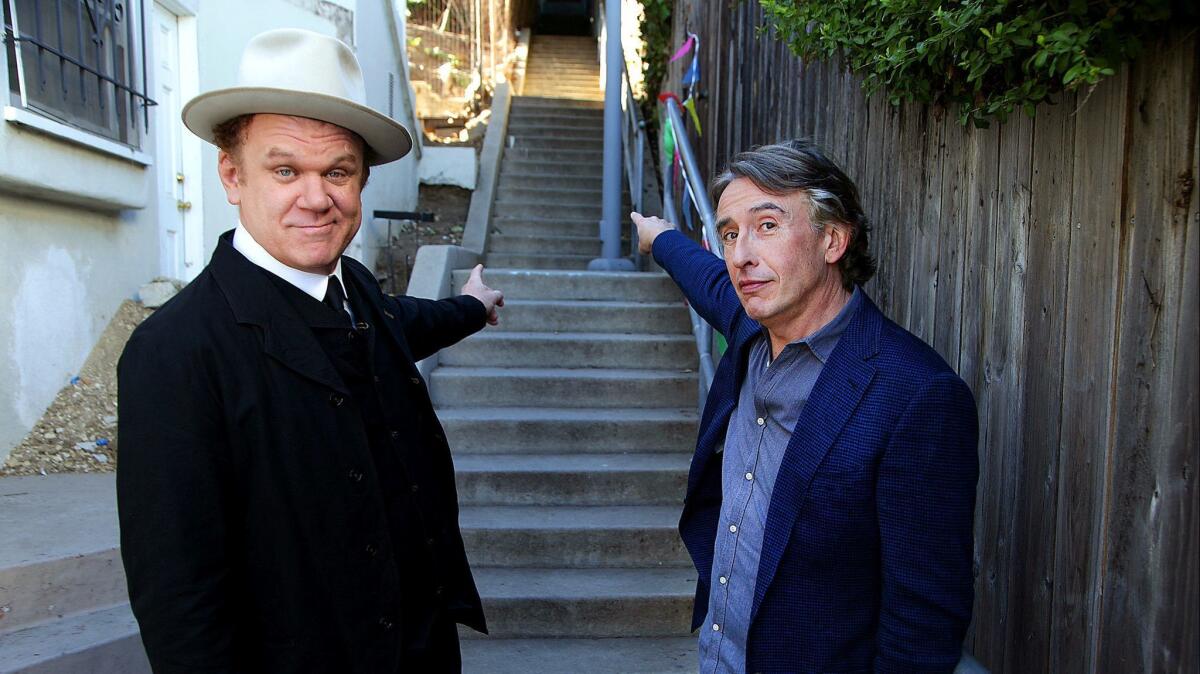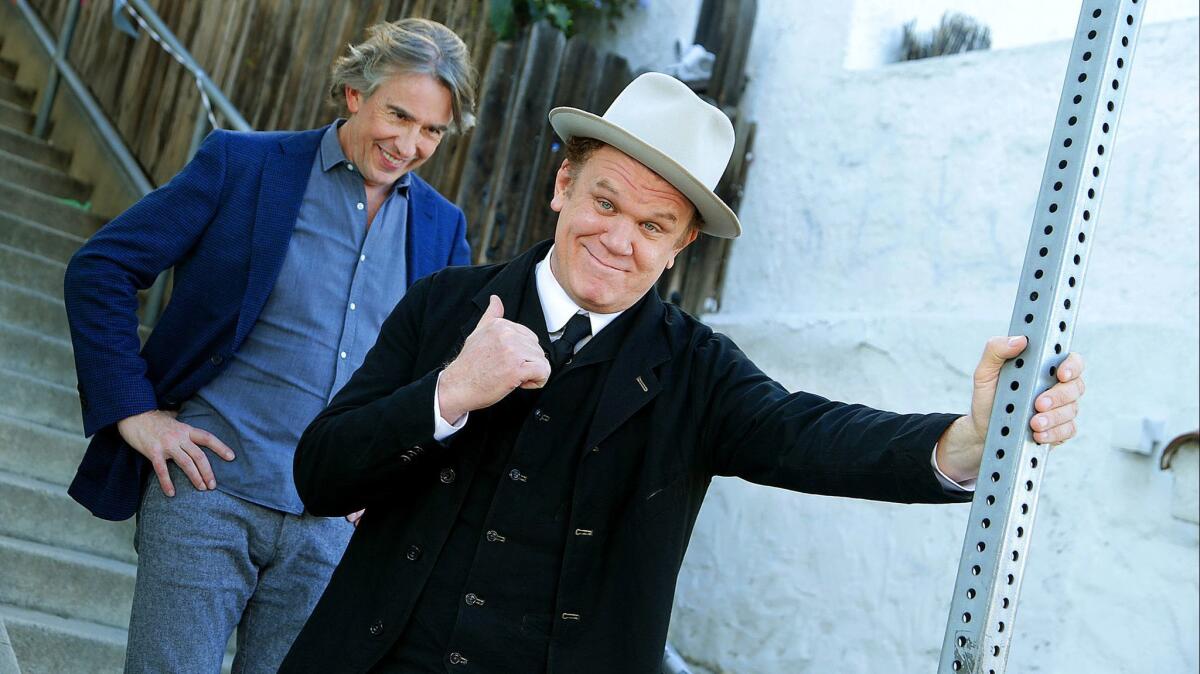Q&A: Steve Coogan and John C. Reilly find their own chemistry in re-creating Laurel and Hardy

- Share via
Early into Jon S. Baird’s loving “Stan & Ollie,” you realize the casting of Steve Coogan and John C. Reilly as legendary comedians Stan Laurel and Oliver Hardy was brilliant. Coogan’s a master of mimicry who started his career on “Spitting Image,” a British celebrity-lampooning puppet show, and Reilly’s classically trained. Yet before signing onto this bittersweet 1950s-era story of the final days of the iconic slapstick double act, both men engaged in lots of hand-wringing.
Reilly says his concerns were about legacy-ruining. “Steve is a very natural mimic, but that’s not what I do as an actor,” says Reilly. “I wanted to honor [Laurel & Hardy], not be a liability for them.” “They were so well known that potentially it was a poisoned chalice,” Coogan adds. “But at the end of the day you think, ‘If he [points to Reilly] is onboard, I’ll do it.’ I knew I’d have a good, talented, reliable partner in crime.’ ”
Recently, the two men sat alongside each other in a Beverly Wilshire hotel room and talked about becoming a mutual admiration society.
Talk about building comedy team chemistry.
Coogan: We had a month’s rehearsal. It was pretty much us together the whole time except for a couple of moments.
Reilly: Chemistry can be a very mysterious thing. It’s like, [mock-theatrically] “When I met my wife I knew we had chemistry.” Chemistry is thought of as this magical thing that gets sprinkled like fairy dust on you. In fact, you can [create] chemistry. The way you do it is by failing in front of each other. Being brave enough to make mistakes, not be good, not be funny, forget a dance step or sing a flat note and your partner forgives you anyway —
Coogan: I forgave John so much [laughs]
Reilly: — or supports you in those moments when you’re struggling, then you get closer and closer and suddenly you have chemistry. It’s a process of trust that has to be earned.
Steve, what part of Stan Laurel came easily?
Coogan: The way he talks. I’ve always been fascinated that he had a transatlantic accent — it’s half-English, half-American. His expression would change radically from beat to beat. So he’s smiling about something, then confused, then happy, then angry. Thirty years ago, I started out as a guy who did funny voices. But I kind of hated that. What I wanted instead was to use [impersonations] as a tool in my arsenal. With Method acting you start with the ingredients and you build something up. This is topsy-turvy. You’re trying to start at the end point and then go backwards.
John, what helped you bring Ollie to life?
Reilly: The first thing I said to Jon was, ‘Are we going to get the best people to do this?’ And he said, ‘Absolutely,’ and we did. Once that was established, I knew, “At least I’ll look like him.” And if I looked like him, then I just had to find out what he was like inside. That was rewarding because he was a very interesting guy — emotional, romantic.
What’s the trick to wearing a fat suit and a fake double chin?
Reilly: You kind of have to own it, accept it as your body. The design [process] was interesting. The first couple of iterations of the fat suit had a lot of gravity. Like this big belly hanging down. It looked sad. Oliver was never sad looking, he always held himself from the center of his chest, almost in denial of his weight. Like he was Gene Kelly, but 300 pounds.
Coogan: He was at ease with his physicality. He wasn’t apologetic.
Reilly: His nickname was Babe and that’s because he looked like a baby his whole life. I kept thinking, “Why doesn’t it look right?” Then I was, like, “It should look like a baby!” I started sending pictures of fat babies to the costume and makeup guy. Babies have weight all over the place rather than one giant belly hanging down.
What was it like performing as Laurel and Hardy in front of an audience of extras?
Reilly: [The extras] didn’t get a script before they came. They were just told, “You’re a theatergoer. You’ll work for eight hours. We’ll give you a sandwich.” They don’t know what’s going to happen.
Coogan: Then we’d come out and do routines. Some were exact renditions, others were invented, a Laurel and Hardy style.
Reilly: Movies are made in such small pieces that part of you is often like, “I don’t know if this is going to actually work.” So as you go along, it’s this process of faith. Like, “I hope we’re going in the right direction. I hope I’m doing a good job.”
One day we went onstage and did a whole sketch and as we were doing it we could hear just gales of laughter from the extras. I looked out and saw the delight, the joy in their faces. When I came offstage I realized that we’d become a part of that same mission: We are doing the things that they did and having the same effect on strangers. I saw it. I saw it in that woman’s face. And it was so overwhelming that I just started to cry.

More to Read
From the Oscars to the Emmys.
Get the Envelope newsletter for exclusive awards season coverage, behind-the-scenes stories from the Envelope podcast and columnist Glenn Whipp’s must-read analysis.
You may occasionally receive promotional content from the Los Angeles Times.









